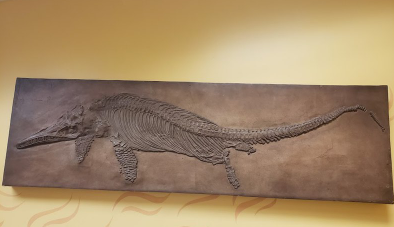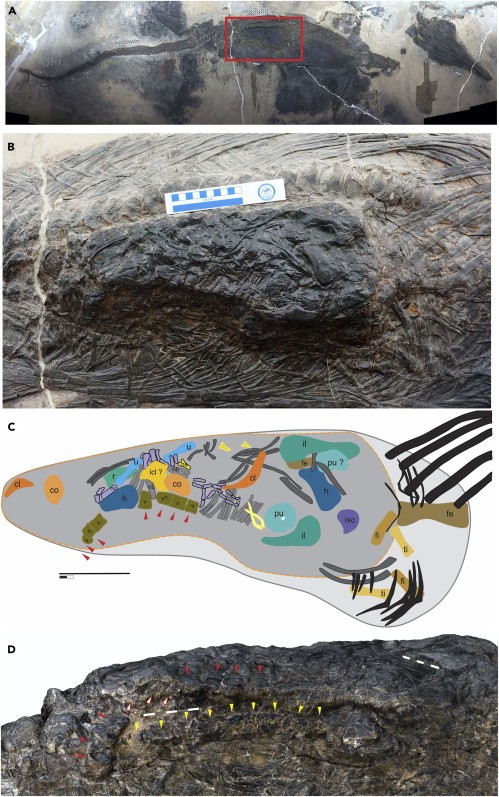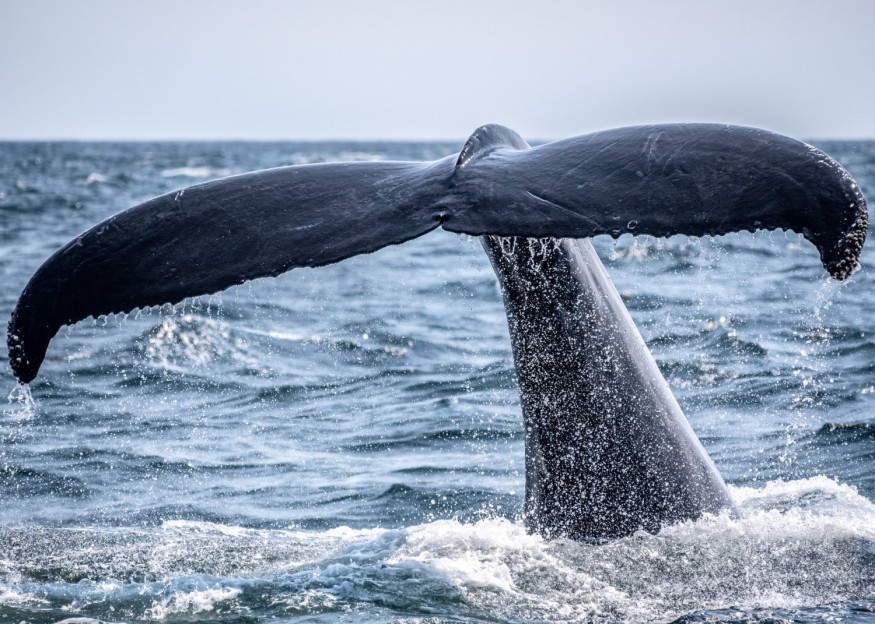The two-meter skull of the earliest known species of giant ichthyosaur sheds new light on the marine reptiles' rapid growth into behemoths of the Dinosaurian oceans. It helps us better understand the journey of modern cetaceans (whales and dolphins) to become the largest animals ever to inhabit the Earth.

Ichthyosaurs
While dinosaurs dominated the land, ichthyosaurs and other aquatic reptiles (not dinosaurs) ruled the seas, growing to enormous proportions and diverse species. Ichthyosaurs roamed the ancient waters for practically the whole Age of Dinosaurs, with their evolving fins and hydrodynamic body forms visible in both fish and whales.
"Ichthyosaurs descended from a previously unknown group of land-dwelling reptiles that were air-breathing," explains lead author Dr. Martin Sander, a paleontologist at the University of Bonn and Research Associate at the Natural History Museum of Los Angeles County's Dinosaur Institute (NHM). "These 'fish-saurians' were among the first huge fossil reptiles known to science, far before the dinosaurs, and they have caught the popular imagination ever since the first skeletal finds in southern England and Germany over 250 years ago."
Well Preserved Fossil

The well-preserved head, together with parts of the backbone, shoulder, and forefin, was discovered in the Augusta Mountains of Nevada and dated back to the Middle Triassic (247.2-237 million years ago), making it the earliest instance of an ichthyosaur of epic proportions. The newly named Cymbospondylus youngorum is the biggest animal yet discovered from that time period, on land or in the sea, measuring more than 17 meters (55.78 ft) long. It was the first known enormous species ever to inhabit the Earth.
"The significance of the find was not immediately apparent," Dr. Sander explains, "because only a few vertebrae were exposed on the side of the canyon. However, the anatomy of the vertebrae suggested that the animal's front end might still be hidden in the rocks. Then, on a cold September day in 2011, the crew needed a warm-up and tested this suggestion by excavation, finding the skull, forelimbs, and chest region."
The new name reflects a happy coincidence: the fieldwork was sponsored by Great Basin Brewery of Reno, owned and run by Tom and Bonda Young, the creators of the regionally renowned Icky beer, which portrays an ichthyosaur on its title.
Since 1902, paleontologists have been recovering fossils from the Fossil Hill Member's limestone, shale, and siltstone in various Nevada mountain ranges, providing a window into the Triassic. Many kinds of ammonites, shelled progenitors of current cephalopods like cuttlefish and octopuses and marine reptiles, have been formed by the mountains, which connect our present to ancient oceans. The Fossil Hill Fauna is a collection of animal species representing many of C. youngorum's prey and rivals.
C. youngorum
C. youngorum stalked the seas 246 million years ago, just three million years after the earliest ichthyosaurs got their fins wet, a brief period to become this large. The conical teeth and lengthened nose imply that C. youngorum ate squid and fish, but it might have also eaten smaller and younger sea reptiles because of its size.
There was most likely some stiff competition for the colossal predator. The authors evaluated the potential energy flowing through the Fossil Hill Fauna's food network using advanced computational modeling, recreating the ancient ecosystem through data, and discovered that marine food webs might support a few more massive meat-eating ichthyosaurs. From little dolphins to gigantic filter-feeding baleen whales and giant squid-hunting sperm whales, ichthyosaurs of all sizes and survival tactics thrived, similar to modern cetaceans.
Opening Doors for Modern Giant Studies

"One rather unique aspect of this project is the integrative nature of our approach," says senior author Dr. Lars Schmitz, Associate Professor of Biology at Scripps College and Dinosaur Institute Research Associate. "We first had to describe the anatomy of the giant skull in detail and determine how this animal is related to other ichthyosaurs." "We didn't stop there; we wanted to understand the significance of the discovery in the context of the large-scale evolutionary pattern of ichthyosaur and whale body sizes, as well as how the Fossil Hill Fauna's fossil ecosystem might have functioned. Both the evolutionary and ecological analyses required a significant amount of computation, eventually leading to a convergence of modeling and traditional paleontology."
For more prehistoric news, don't forget to follow Nature World News!
© 2025 NatureWorldNews.com All rights reserved. Do not reproduce without permission.





